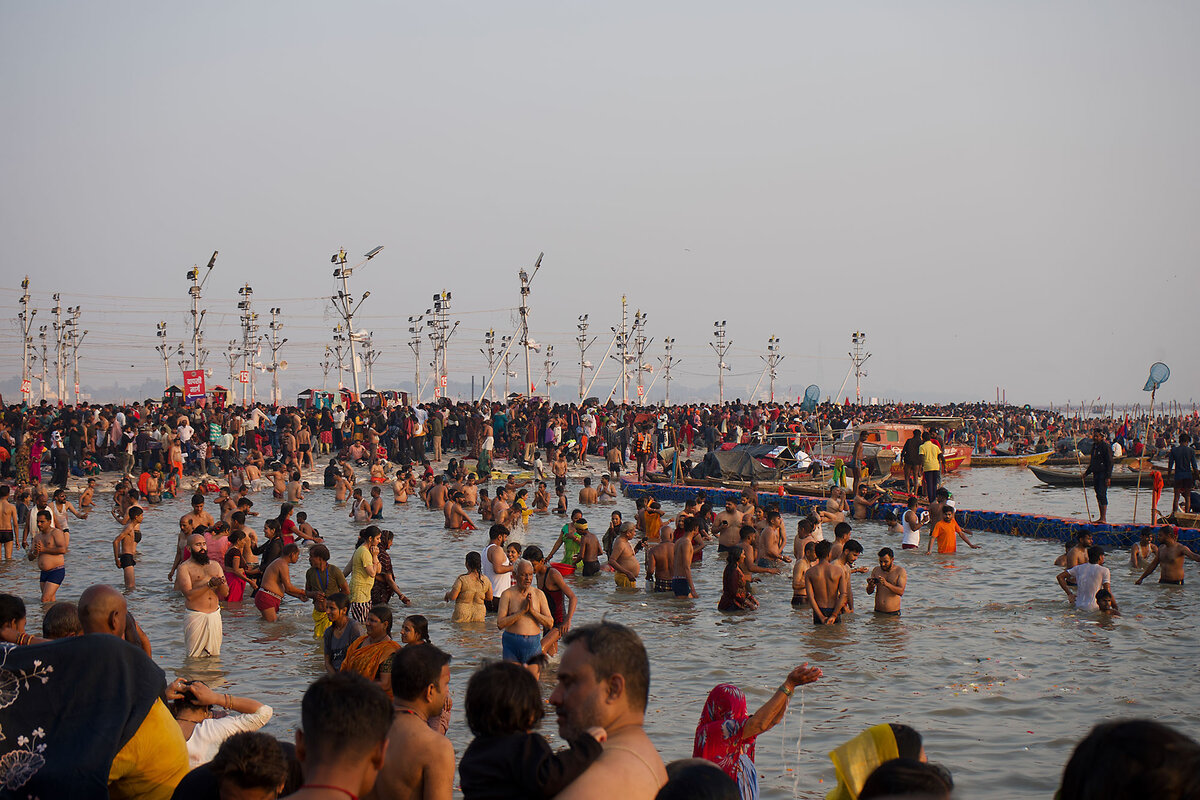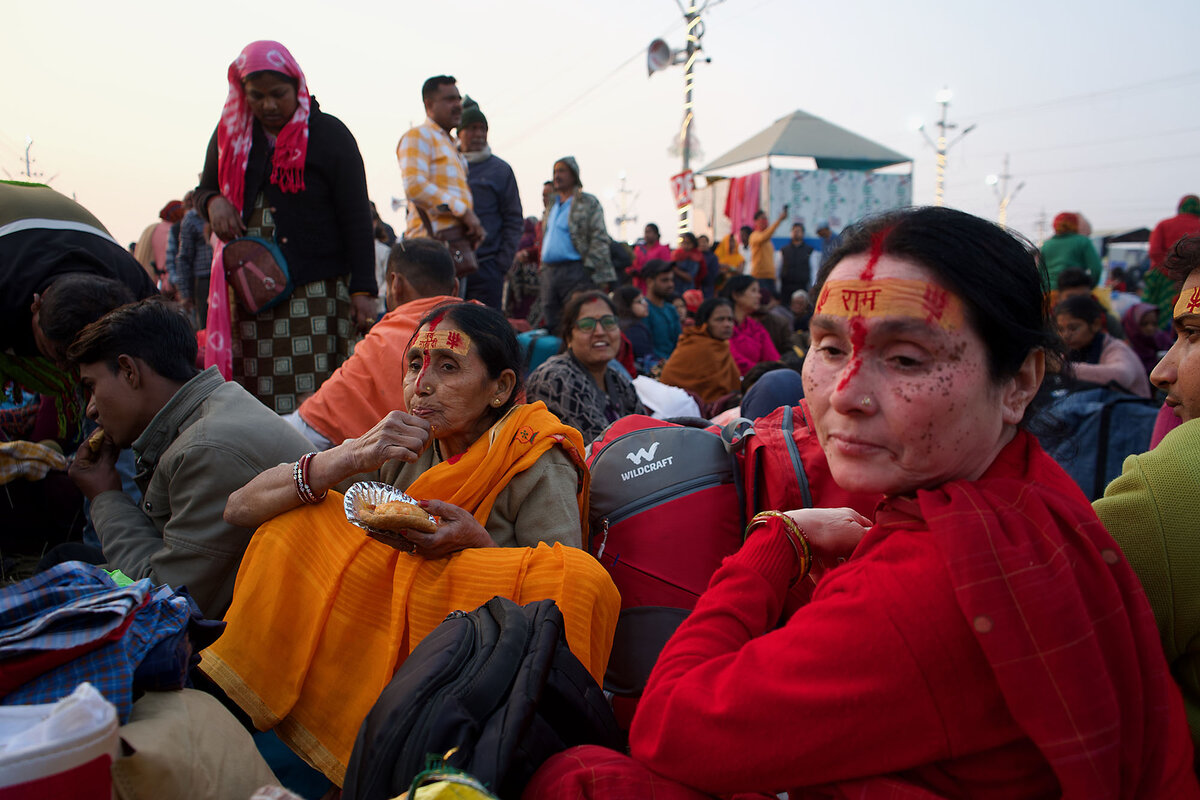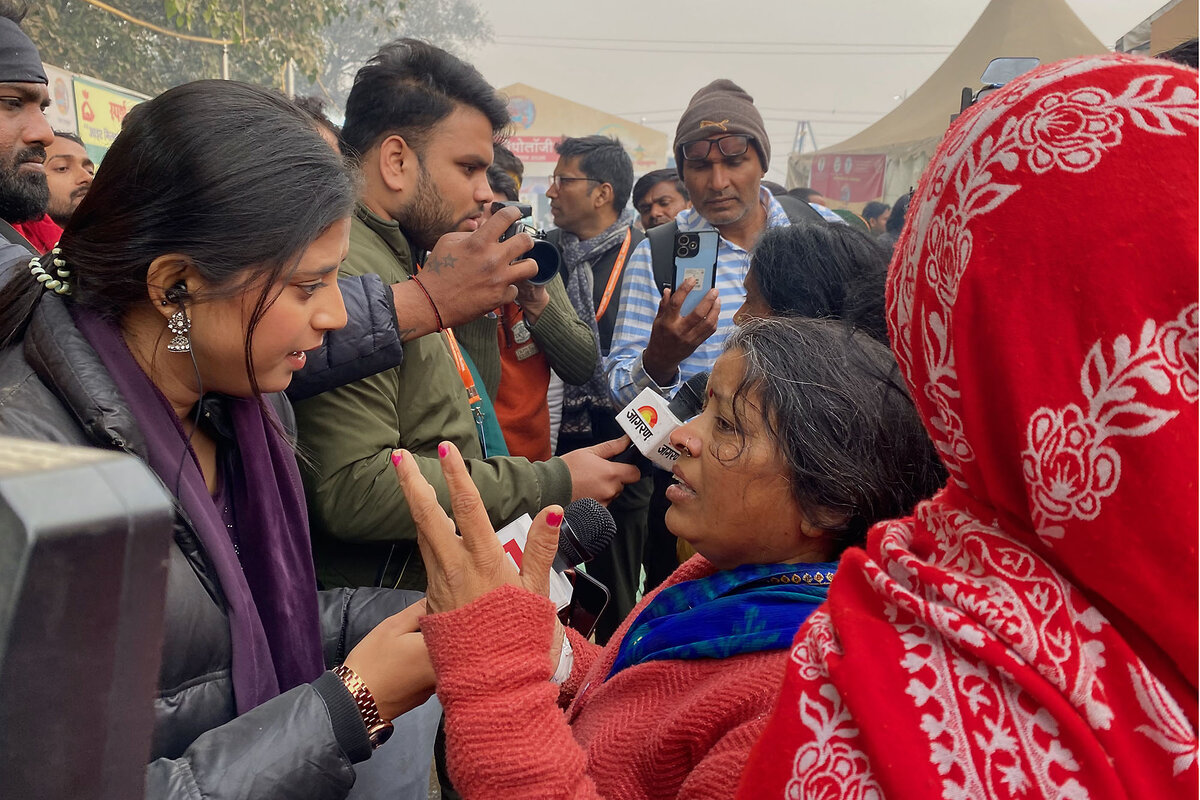He went to capture the beauty of Hinduism. Then the stampede happened.
| Prayagraj, India
The world’s largest festival – a Hindu one in northern India – seemed like the perfect opportunity as a reporter to shine a light on the sheer beauty of Hinduism at a time when the religion has become politicized under Prime Minister Narendra Modi.
Instead, the trip ended in tragedy.
Millions have gathered in Prayagraj for the Kumbh Mela, a weekslong festival held every 12 years. Wednesday was meant to be the most auspicious day, due to a rare astrological alignment, and authorities were expecting around 100 million people to gather here to see Hindu priests dip into the Ganges – about 33 times the number of pilgrims who make the annual trip to Mecca. It would be telecast across the country.
Why We Wrote This
Our reporter’s trip to the world’s largest holy festival was interrupted by a deadly stampede. His account reveals both the risks and the spiritual importance of the Kumbh Mela, and how India’s relationship with Hinduism is changing.
But late Tuesday night, while I was preparing to capture the joy and religious fervor that drives the Kumbh Mela, a photographer colleague told me there’d been a commotion upstream. It took an hour to get to the site of the accident, moving against the crowds, and even longer for the details of what happened to crystalize.
Reveler Narayan Singh Lodhi helped fill in the blanks. His family was sleeping under the open sky when a disturbance woke them up around midnight. There were too many people pushing. Some began to fall. Mr. Lodhi tried to rescue people as a stampede started, but he could only grab hold of his wife and one other woman. “I dragged them out,” he says. “There were dozens of others who were screaming for help.”
Police say at least 30 people have died and many more were injured after what eyewitnesses describe as multiple stampedes.
Mr. Lodhi’s sister-in-law is among those who died.
“Our happiness has upended into mourning,” says Mr. Lodhi, blaming poor crowd management for the tragedy. “I don’t know how we will go home with this loss. We are shattered.”
On Tuesday, 50 million devotees had taken a bath in the holy river, and in the immediate hours after the stampedes, authorities say, millions more got in the water. The priests, however, postponed their holy bath until later in the day.
“We cannot celebrate when such a tragedy has struck,” says Jai Krishan Mahraj, a priest who decided to not enter the water on Wednesday at all. “I am feeling extremely sad, and the devotees are also in a somber mood.”
Before the stampedes, I did have the privilege to experience the revelry that marks the Kumbh Mela.
Like when I met Charan Singh Jaiswal and his wife, Sunita Devi, who traveled for two days from their remote hometown of Mandi in the Himalayan mountains to take the holy dip. With the rising sun, the couple descended into the thigh-deep water, held each other’s hands, and plunged into the river.
“Both my body and soul have been cleansed,” announced Mr. Jaiswal as he climbed back on the strand, shivering in the cold and quickly wrapping himself in a saffron towel. Ms. Devi took a few more dips, bowed before the sun, and “felt inner peace,” she says.
Even then, the crowds had kicked up perpetual clouds of dust. Religious singing mixed with the hum of drones, which had been deployed to keep an eye on crowd movements. A helicopter floated above the busiest area – the confluence of the Ganges, Yamuna, and mythical Saraswati rivers. From Day 1, the festival has been a chaotic and jam-packed affair – not entirely unlike the festivals before it.
The Kumbh Mela’s origins are hazy, with some theories tracing back to the seventh century, but the festival as we know it today began in the late 1700s, says James Lochtefeld, religion professor at Carthage College in Kenosha, Wisconsin. By the 18th century, the 13 major ascetic akharas, or sects of Hindu priests, played a central role in Kumbh Mela rituals. Big crowds have always been part of the festival, and a challenge that the government – whether it was British colonial rulers or Hindu volunteer groups in independent India – had to face.
This year is the first time the festival has been held since Mr. Modi became the prime minister of India in 2014, reviving a polarized brand of Hindu nationalism. The Kumbh Mela was not completely spared from politics. The city’s Mughal-era name, Allahabad, was recently changed to Prayagraj as part of the Modi government’s campaign to strip cities and landmarks of their Muslim names in favor of Hindu titles. And local Muslims, who used to set up shops on the banks of the Ganges, say they have been warned to stay away this year.
But for ordinary pilgrims, the spiritual significance of the Kumbh Mela eclipsed politics, at least for a moment in time.
Krishna Shah drove 16 hours from the western state of Gujarat and walked 15 kilometers (9 miles) to reach the bathing site, believing it to be one of the “most sacred” acts a Hindu can commit.
Hinduism for him means treating everything as God, and he treats this festival as the “convergence of gods with humans” in the waters of the river Ganges. He believes the most beautiful aspect of Hinduism is “praying and believing in God in your own way.”
“There are no hard and fast rules,” he says, looking over the vast crowds of devotees. “You can pray as you like, as long as you like, and at the time you like. Hinduism is flexible and accommodative of everyone.”









